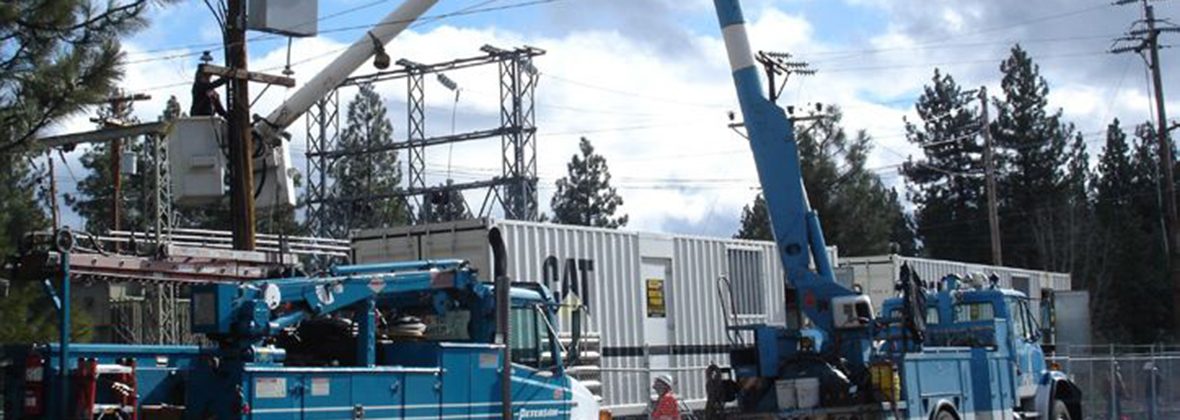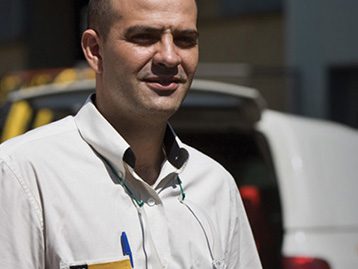
Temporary Power Supports Grid Maintenance
Replacing utility poles, company parallels Cat® power modules
Customer: Pacific Gas and Electric Company (PG&E)
Location: Chester, California
Customer Business Issue: Parallel power supply for a 72-hour construction project to replace 41 power poles serving the town of Chester, California
Solution:
Two Cat® 2,500 kV transformers
Two Cat XQ2000 utility-grade power modules
2,000 feet of power cable
Cat Dealer: Peterson Power Systems, Inc.
Power Need
In mid-November 2007, the town of Chester, California was preparing to undergo a 72-hour power shutdown so that Pacific Gas and Electric (PG&E) could replace 41 power poles and their cross-arms on its Hamilton Branch transmission line, which serves the Chester community. PG&E’s North Valley General Construction Line Division (GC Line) contracted with Peterson Power Systems, Inc. (Peterson), the local authorized Cat® dealer, to provide temporary power to the town during this shutdown.
San Francisco-based PG&E, one of the largest combination natural gas and electric utilities in the United States, was incorporated in California in 1905. PG&E employs approximately 20,000 people and delivers energy to approximately 15 million people throughout a 70,000-square-mile service area that stretches north to south from Eureka to Bakersfield and from the Pacific Ocean to the Sierra Nevada and Cascade mountain ranges. PG&E’s electric system alone totals 123,054 circuit miles of distribution lines and 18,610 circuit miles of interconnected transmission lines, serving a total of 5.1 million residential and commercial electric power customers.
Serving northern California and central and southern Oregon, Peterson offers a wide array of power generation and engine services, including sales, rental, parts and repair. Based in San Leandro, the dealership’s California locations include Benicia, Redding and Santa Rosa, with an additional location in Springfield, Oregon.
PG&E’s Chester Substation serves 1,652 electric meters in the community, with a combined electric demand ranging from 1.9 MW to 2.4 MW. PG&E has been very proactive in efforts to improve its service reliability in Chester after past sustained outages due to circuit configuration, condition and exposure. Because of PG&E’s commitment to customer service in the Chester area, maintaining the power supply to its customers and minimizing the extent and duration of any power interruptions was a top priority for the company.
“PG&E’s ongoing commitment to customer satisfaction is what really drove the project,” said Kevin Kent, new sales and rental manager for Peterson. “PG&E is committed to maintaining their service uptime percentage as high as possible, so a prolonged outage was really not a viable option.” Therefore, PG&E ruled out the alternative of conducting two 12-hour night electric “clearances,” or scheduled outages, which would have generated approximately 2,378,880 outage minutes for its customers. In addition, the clearances would have necessitated substantial GC Line overtime staffing and raised concerns surrounding the safety of general construction (GC) line crews working through the night and the non-productive time associated with their rest periods and mobilization.
PG&E knew it needed a solution that would keep Chester’s power on but still allow the poles to be replaced safely and cost-effectively.
It was soon thereafter that Kent met PG&E’s Regional Project Manager Peter Johnson at a transmission yard in Chico, after he noticed Johnson seemed interested in a generator set in the yard. Kent worked with PG&E to define the specific needs and scope of the project, and a firm plan soon emerged. PG&E chose to have GC Line contract with Peterson to provide service to Chester customers utilizing two 2 MW generating units operated by Peterson through a parallel configuration with the PG&E power supply. With this configuration, only two brief electric clearances, totaling less than 30 seconds, were necessary.
Solution
Peterson installed two Cat XQ2000 power modules and the necessary relays and transformers to provide the 12 kV distribution feed. PG&E increased the system protection scheme by adding three special re-closers to enable paralleling in and out of the PG&E utility circuit and by installing an underground grounding grid. In addition, PG&E tied the two feeder outlets to receive the generated power through a single source. PG&E then transferred the load through a generator-parallel momentary outage lasting under 30 seconds and received the load through a parallel with the same outage duration.
For Peterson, the critical test of the system came at approximately 1 a.m. on the day before the switchover was to occur. Mike Pullens, Peterson’s power generation technician, started the two Cat generators and paralleled the two generator sets together.
According to Pullens, the result was perfect. “These are very quiet generator sets, so the assembled crowd waited in silence as the generators instantly paralleled with the PG&E grid,” Pullens explained. They soon knew they had achieved success with the paralleling when the sound of the click from the re-closure switch was heard by all.
The temporary power system was now completely operational for its scheduled 11 p.m. go-live time, when the PG&E team would cut their utility’s power supply and leave Chester’s power customers in the hands of the Cat generator sets. “When the time came to flip the switch, those generators never missed a beat,” said Kent.
In addition to the temporary ground grid modifications at the Chester substation, Peterson installed a temporary fence to enclose the Cat generator sets. Using a total crew of 45 workers and a small fleet of bucket trucks, the utility company then replaced the aging 55-foot wooden utility poles. Each of the 41 new poles installed also received new horizontal wooden cross-arms and insulators.
Results
Careful preparation and testing proved critical in ensuring the success of the project, according to Kent. “Our capability and resources made the difference,” said Kent. Peterson has the Cat equipment, the factory-trained technicians and the infrastructure to support a project of this magnitude,” Kent said.
Other factors helped ensure success, as well. “We had utility-grade power modules that were CARB (California Air Resources Board)-certified so we could parallel in with PG&E and have a smooth transition in and out,” explained Kent.
As with any project of this magnitude, a fair amount of work that was required of PG&E occurred behind the scenes, especially on the re-closers, but it was very successful, Kent said. In addition to Pullens’ work as lead technician, Peterson’s coordinators James Gray and Norm Lenz were instrumental in ensuring a successful outcome.
Chester’s lights remained on, and the aging poles were replaced. PG&E avoided the combination of lost power sales during any outage and the added expense of having to work crews around the clock for the 72 hours to replace all the poles. But most importantly, PG&E was able to keep the power flowing to its customers.

Rental Gensets
Cat Rental Power is always standing by to get you set up and running quickly with the largest global fleet of generator sets, temperature control units, and compressed air equipment, all built exclusively for rental applications.
View Products
Rental Power
Cat Rental Power delivers clean, reliable, fuel-efficient gensets whenever and wherever you need them.
Rental Power Home
We're right around the corner
Find what you need fast at one of our 1,300+ locations. Chances are there’s one just around the corner.
Find a Dealer